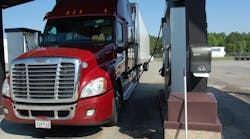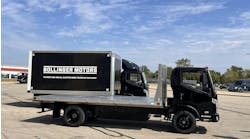Average retail pump prices for both diesel and gasoline continued increasing this week, according to data tracked by the Energy Information Administration (EIA), with the price hikes for gasoline partly due to growing uncertainty regarding the cost of ethanol.
Diesel jumped up 3.5 cents this week to a national average of $2.90 per gallon, though that is $1.117 per gallon cheaper compared to the same week last year, EIA noted.
The agency said diesel prices increased in all regions of the country except for the Rocky Mountains, where prices dropped 8/10ths of a penny this week to $2.762 per gallon.
The biggest upticks in regional diesel prices also mirrored areas where diesel exceeded the $3 per gallon mark, EIA added:
- New England: up 8.9 cents to $3.173 per gallon
- Central Atlantic: up 7.6 cents to $3.173
- West Coast: up 6.8 cents to $3.065. (Note: that shifts to an increase of 7.2 cents to $2.899 with California removed from the mix.)
- California: up 6.6 cents to $3.208
- East Coast: up 4.5 cents to $3.005
Gasoline jumped 5.8 cents to a national average of $2.332 per gallon this week, EIA noted, though that is $1.112 per gallon cheaper compared to the same week in 2014.
Prices for gasoline increased in every region of the U.S. this week, the agency added, with the biggest spike out on the West Coast at 13.6 cents to $2.758 per gallon, which changes to 9.2 cents to $2.411 with California’s prices removed from the mix.
A corresponding spike in ethanol prices over the last two months is also adding some uncertainty to gasoline price forecasts, EIA noted in a separate report, as ethanol must gasoline be blended into gasoline up to a 10% level.
With the exception of two short periods in late 2013 and the first quarter of 2014, when winter-related logistical bottlenecks drove up ethanol prices, spot ethanol prices have consistently been lower than gasoline prices from December 2011 through October 2014.
However, with the sharp decline in crude oil and gasoline prices that began midway through last year, gasoline spot prices fell below ethanol spot prices in early November.
As a result, for most of December through mid-January, ethanol cost about 30 cents per gallon more than wholesale gasoline, though that “price gap” has narrowed as of late, the agency reported.
The pricing difference can impact the incentive to blend ethanol into gasoline, EIA noted, which factors into the Renewable Identification Numbers (RINs) associated with each gallon of ethanol that is blended into gasoline.
RINs were introduced as a compliance mechanism for the Renewable Fuel Standard (RFS) program administered by the Environmental Protection Agency (EPA) under laws enacted in 2005 and 2007 and in recent years the D6 RIN, primarily generated via corn ethanol production, has increased in value during times of higher target announcements or impending compliance deadlines.
The recent increase in the D6 RIN price appears to be driven at least in part by the decline in gasoline price, EIA noted.
Current RIN values may also be affected by uncertainty regarding RFS requirements that the EPA might ultimately promulgate for the 2014 and 2015 RFS program years, the agency said.
EPA has yet to establish a rule setting the number of RINs that obligated parties will need to cover their RFS obligation for sales made in 2014 and has also not proposed, let alone promulgated, rules for the 2015 RFS program year, which by law were to be issued back in November, two months prior to the start of the program year.
Thus the uncertainty surrounding the finalization of RFS targets for 2014 and 2015, together with the gasoline blending economics discussed above, may also be contributing to recent RIN price developments, EIA noted.



